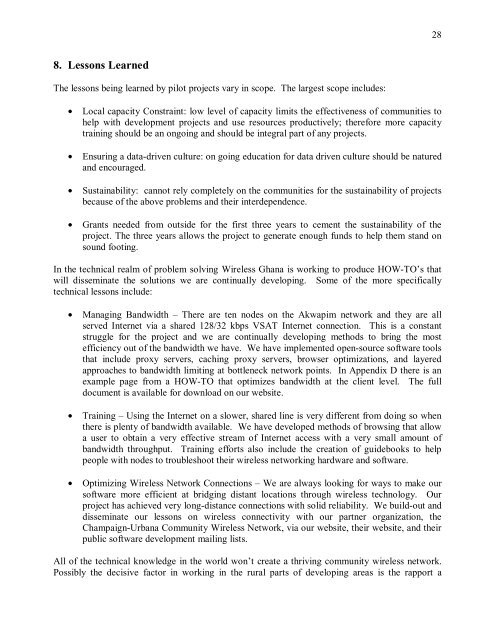Wireless Ghana: A Case Study
Wireless Ghana: A Case Study
Wireless Ghana: A Case Study
You also want an ePaper? Increase the reach of your titles
YUMPU automatically turns print PDFs into web optimized ePapers that Google loves.
28<br />
8. Lessons Learned<br />
The lessons being learned by pilot projects vary in scope. The largest scope includes:<br />
• Local capacity Constraint: low level of capacity limits the effectiveness of communities to<br />
help with development projects and use resources productively; therefore more capacity<br />
training should be an ongoing and should be integral part of any projects.<br />
• Ensuring a data-driven culture: on going education for data driven culture should be natured<br />
and encouraged.<br />
• Sustainability: cannot rely completely on the communities for the sustainability of projects<br />
because of the above problems and their interdependence.<br />
• Grants needed from outside for the first three years to cement the sustainability of the<br />
project. The three years allows the project to generate enough funds to help them stand on<br />
sound footing.<br />
In the technical realm of problem solving <strong>Wireless</strong> <strong>Ghana</strong> is working to produce HOW-TO’s that<br />
will disseminate the solutions we are continually developing. Some of the more specifically<br />
technical lessons include:<br />
• Managing Bandwidth – There are ten nodes on the Akwapim network and they are all<br />
served Internet via a shared 128/32 kbps VSAT Internet connection. This is a constant<br />
struggle for the project and we are continually developing methods to bring the most<br />
efficiency out of the bandwidth we have. We have implemented open-source software tools<br />
that include proxy servers, caching proxy servers, browser optimizations, and layered<br />
approaches to bandwidth limiting at bottleneck network points. In Appendix D there is an<br />
example page from a HOW-TO that optimizes bandwidth at the client level. The full<br />
document is available for download on our website.<br />
• Training – Using the Internet on a slower, shared line is very different from doing so when<br />
there is plenty of bandwidth available. We have developed methods of browsing that allow<br />
a user to obtain a very effective stream of Internet access with a very small amount of<br />
bandwidth throughput. Training efforts also include the creation of guidebooks to help<br />
people with nodes to troubleshoot their wireless networking hardware and software.<br />
• Optimizing <strong>Wireless</strong> Network Connections – We are always looking for ways to make our<br />
software more efficient at bridging distant locations through wireless technology. Our<br />
project has achieved very long-distance connections with solid reliability. We build-out and<br />
disseminate our lessons on wireless connectivity with our partner organization, the<br />
Champaign-Urbana Community <strong>Wireless</strong> Network, via our website, their website, and their<br />
public software development mailing lists.<br />
All of the technical knowledge in the world won’t create a thriving community wireless network.<br />
Possibly the decisive factor in working in the rural parts of developing areas is the rapport a


